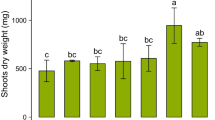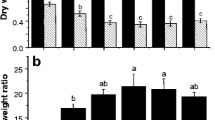Abstract
The effects of elevated CO2 on metal species and mobility in the rhizosphere of hyperaccumulator are not well understood. We report an experiment designed to compare the effects of elevated CO2 on Cd/Zn speciation and mobility in the rhizosphere of hyperaccumulating ecotype (HE) and a non-hyperaccumulating ecotype (NHE) of Sedum alfredii grown under ambient (350 μl l−1) or elevated (800 μl l−1) CO2 conditions. No difference in solution pH of NHE was observed between ambient and elevated CO2 treatments. For HE, however, elevated CO2 reduced soil solution pH by 0.22 unit, as compared to ambient CO2 conditions. Elevated CO2 increased dissolved organic carbon (DOC) and organic acid levels in soil solution of both ecotypes, but the increase in HE solution was much greater than in NHE solution. After the growth of HE, the concentrations of Cd and Zn in soil solution decreased significantly regardless of CO2 level. The visual MINTEQ speciation model predicted that Cd/Zn–DOM complexes were the dominant species in soil solutions, followed by free Cd2+ and Zn2+ species for both ecotypes. However, Cd/Zn–DOM complexes fraction in soil solution of HE was increased by the elevated CO2 treatment (by 8.01 % for Cd and 8.47 % for Zn, respectively). Resin equilibration experiment results indicated that DOM derived from the rhizosphere of HE under elevated CO2 (HE-DOM-E) (90 % for Cd and 73 % for Zn, respectively) showed greater ability to form complexes with Cd and Zn than those under ambient CO2 (HE-DOM-A) (82 % for Cd and 61 % for Zn, respectively) in the undiluted sample. HE-DOM-E showed greater ability to extract Cd and Zn from soil than HE-DOM-A. It was concluded that elevated CO2 could increase the mobility of Cd and Zn due to the enhanced formation of DOM–metal complexes in the rhizosphere of HE S. alfredii.


Similar content being viewed by others

References
Antoniadis V, Alloway BJ (2002) The role of dissolved organic carbon in the mobility of Cd, Ni and Zn in sewage sludge-amended soils. Environ Pollut 117:515–521
Baken S, Degryse F, Verheyen L, Merckx R, Smolders E (2011) Metal complexation properties of freshwater dissolved organic matter are explained by its aromaticity and by anthropogenic ligands. Environ Sci Technol 45:2584–2590
Cerling TE, Harris JM, MacFadden BJ, Leakey MG, Quade J, Eisenmann V, Ehleringer JR (1997) Global vegetation change through the Miocene/Pliocene boundary. Nature 389:153–158
Christensen JB, Christensen TH (2000) The effect of pH on the complexation of Cd, Ni and Zn by dissolved organic carbon from leachate-polluted groundwater. Water Res 34:3743–3754
Cornu JY, Parat C, Schneider A, Authier L, Dauthieu M, Sappin-Didier V, Denaix L (2009) Cadmium speciation assessed by voltammetry, ion exchange and geochemical calculation in soil solutions collected after soil rewetting. Chemosphere 76:502–508
Cornu JY, Schneider A, Jezequel K, Denaix L (2011) Modelling the complexation of Cd in soil solution at different temperatures using the UV-absorbance of dissolved organic matter. Geoderma 162:65–70
Cousins AB, Adam NR, Wall GW, Kimball BA, Pinter PJ, Ottman MJ, Leavitt SW, Webber AN (2003) Development of C-4 photosynthesis in sorghum leaves grown under free-air CO2 enrichment (FACE). J Exp Bot 54:1969–1975
de Graaff MA, Six J, van Kessel C (2007) Elevated CO2 increases nitrogen rhizodeposition and microbial immobilization of root-derived nitrogen. New Phytol 173:778–786
Dijkstra P, Hymus G, Colavito D, Vieglais DA, Cundari CM, Johnson DP, Hungate BA, Hinkle CR, Drake BG (2002) Elevate atmospheric CO2 stimulates aboveground biomass in a fire-regenerated scrub–oak system. Glob Chang Biol 8:90–103
Fitz WJ, Wenzel WW, Zhang H, Nurmi J, Stipek K, Fischerova Z, Schweiger P, Kollensperger G, Ma LQ, Stingeder G (2003) Rhizosphere characteristics of the arsenic hyperaccumulator Pteris vittata L. and monitoring of phytoremoval efficiency. Environ Sci Technol 37:5008–5014
Guo HY, Zhu JG, Zhou H, Sun YT, Yin Y, Pei DP, Ji R, Wu JC, Wang XR (2011) Elevated CO2 levels affects the concentrations of copper and cadmium in crops grown in soil contaminated with heavy metals under fully open-air field conditions. Environ Sci Technol 45:6997–7003
Gustafsson JP (2011) Visual MINTEQ ver 3.0. http://www2.lwr.kth.se/English/OurSoftware/vminteq/
Hungate BA, Dijkstra P, Johnson DW, Hinkle CR, Drake BG (1999) Elevated CO2 increases nitrogen fixation and decreases soil nitrogen mineralization in Florida scrub oak. Glob Chang Biol 5:781–789
IPCC, Solomon S et al (2007) Climate Change 2007, The physical science basis. Contribution of working group I to the fourth assessment report of the Intergovernmental Panel on Climate Change. Cambridge Univ. Press, Cambridge, UK, 2007
Jia Y, Tang SR, Wang RG, Ju XH, Ding YZ, Tu SX, Smith DL (2010) Effects of elevated CO2 on growth, photosynthesis, elemental composition, antioxidant level, and phytochelatin concentration in Lolium mutiforum and Lolium perenne under Cd stress. J Hazard Mater 180:384–394
Jones DL, Willett VB (2006) Experimental evaluation of methods to quantify dissolved organic nitrogen (DON) and dissolved organic carbon (DOC) in soil. Soil Biol Biochem 38:991–999
Khan AG, Kuek C, Chaudhry TM, Khoo CS, Hayes WJ (2000) Role of plants, mycorrhizae and phytochelators in heavy metal contaminated land remediation. Chemosphere 41:197–207
Kim S, Kang H (2011) Effects of elevated CO2 and Pb on phytoextraction and enzyme activity. Water Air Soil Pollut 219:365–375
Kim S, Lim H, Lee I (2010) Enhanced heavy metal phytoextraction by Echinochloa crus-galli using root exudates. J Biosci Bioeng 109:47–50
Kimball BA, Pinter PJ, Garcia RL, LaMorte RL, Wall GW, Hunsaker DJ, Wechsung G, Wechsung F, Kartschall T (1995) Productivity and water use of wheat under free-air CO2 enrichment. Global Chang Biol 1:429–442
Körner C (2001) Biosphere responses to CO2 enrichment. Ecol Appl 10:1590–1619
Kramer U (2005) Phytoremediation: novel approaches to cleaning up polluted soils. Curr Opin Biotechnol 16:133–141
Krishnamurti GS, Megharaj M, Naidu R (2004) Bioavailability of cadmium–organic complexes to soil alga—an exception to the free ion model. J Agric Food Chem 52:3894–3899
Li ZB, Shuman LM (1997) Mobility of Zn, Cd and Pb in soils as affected by poultry litter extract. 1. Leaching in soil columns. Environ Pollut 95:219–226
Li ZY, Tang SR, Deng XF, Wang RG, Song ZG (2010) Contrasting effects of elevated CO2 on Cu and Cd uptake by different rice varieties grown on contaminated soils with two levels of metals: implication for phytoextraction and food safety. J Hazard Mater 177:352–361
Li TQ, Di ZZ, Han X, Yang XE (2012a) Elevated CO2 improves root growth and cadmium accumulation in the hyperaccumulator Sedum alfredii. Plant Soil 354:325–334
Li TQ, Xu ZH, Han X, Yang XE, Sparks DL (2012b) Characterization of dissolved organic matter in the rhizosphere of hyperaccumulator Sedum alfredii and its effect on the mobility of zinc. Chemosphere 88:570–576
Li TQ, Tao Q, Han X, Yang XE (2013a) Effects of elevated CO2 on rhizosphere characteristics of Cd/Zn hyperaccumulator Sedum alfredii. Sci Total Environ 454–455:510–516
Li TQ, Liang CF, Tao Q, Yang XE (2013b) Mobilization of cadmium by dissolved organic matter in the rhizosphere of hyperaccumulator Sedum alfredii. Chemosphere 91:70–976
Lieffering M, Kim HY, Kobayashi K, Okada M (2004) The impact of elevated CO2 on the elemental concentrations of field-grown rice grains. Field Crop Res 88:279–286
Lorenz SE, Hamon RE, Holm PE, Domingues HC, Sequeira EM, Christensen TH, McGrath SP (1997) Cadmium and zinc in plants and soil solutions from contaminated soils. Plant Soil 189:21–31
Luttge U (2004) Ecophysiology of crassulacean acid metabolism (CAM). Ann Bot Lond 93:629–652
McGrath SP, Shen ZG, Zhao FJ (1997) Heavy metal uptake and chemical changes in the rhizosphere of Thlaspi caerulescens and Thlaspi ochroleucum grown in contaminated soils. Plant Soil 188:153–159
Milne CJ, Kinniburgh DG, van Riemsdijk WH, Tipping E (2003) Generic NICA-Donnan model parameters for metal-ion binding by humic substances. Environ Sci Technol 37:958–971
Mishra S, Heckathorn SA, Frantz JM (2012) Elevated CO2 affects plant responses to variation in boron availability. Plant Soil 350:117–130
Nolan AL, McLaughlin MJ, Mason SD (2003) Chemical speciation of Zn, Cd, Cu, and Pb in pore waters of agricultural and contaminated soils using Donnan dialysis. Environ Sci Technol 37:90–98
Noyes PD, McElwee MK, Miller HD, Clark BW, Van Tiem LA, Walcott KC, Erwin KN, Levin ED (2009) The toxicology of climate change: Environmental contaminants in a warming world. Environ Int 35:971–986
Peris M, Mico C, Recatala L, Sanchez R, Sanchez J (2007) Heavy metal contents in horticultural crops of a representative area of the European Mediterranean region. Sci Total Environ 378:42–48
Phillips RP, Bernhardt ES, Schlesinger WH (2009) Elevated CO2 increases root exudation from loblolly pine (Pinus taeda) seedlings as an N-mediated response. Tree Physiol 29:1513–1523
Rajkumar M, Prasad MNV, Swaminathan S, Freitas H (2013) Climate change driven plant–metal–microbe interactions. Environ Int 53:74–86
Rodriguez JH, Klumpp A, Fangmeier A, Pignata ML (2011) Effects of elevated CO2 concentrations and fly ash amended soils on trace element accumulation and translocation among roots, stems and seeds of Glycine max (L.) Merr. J Hazard Mater 187:58–66
Sauve S, Norvell WA, McBride M, Hendershot W (2000) Speciation and complexation of cadmium in extracted soil solutions. Environ Sci Technol 34:291–296
Schmitt D, Saravia F, Frimmel FH, Schuessler W (2003) NOM-facilitated transport of metal ions in aquifers: importance of complex-dissociation kinetics and colloid formation. Water Res 37:3541–3550
Tang S, Xi L, Zheng J, Li H (2003) Response to elevated CO2 of Indian mustard and sunflower growing on copper contaminated soil. Bull Environ Contam Toxicol 71:988–997
Terzano R, Spagnuolo M, Vekemans B, De Nolf W, Janssens K, Falkenberg G, Fiore S, Ruggiero P (2007) Assessing the origin and fate of Cr, Ni, Cu, Zn, Pb, and V in industrial polluted soil by combined microspectroscopic techniques and bulk extraction methods. Environ Sci Technol 41:6762–6769
Tu SX, Ma L, Luongo T (2004) Root exudates and arsenic accumulation in arsenic hyperaccumulating Pteris vittata and non-hyperaccumulating Nephrolepis exaltata. Plant Soil 258:9–19
Vangronsveld J, Herzig R, Weyens N, Boulet J, Adriaensen K, Ruttens A, Thewys T, Vassilev A, Meers E, Nehnevajova E, van der Lelie D, Mench M (2009) Phytoremediation of contaminated soils and groundwater: lessons from the field. Environ Sci Pollut Res 16:765–794
Weng LP, Temminghoff EJM, Lofts S, Tipping E, Van Riemsdijk WH (2002) Complexation with dissolved organic matter and solubility control of heavy metals in a sandy soil. Environ Sci Technol 36:4804–4810
Wu HB, Tang SR, Zhang XM, Guo JK, Song ZG, Tian SA, Smith DL (2009) Using elevated CO2 to increase the biomass of a Sorghum vulgare × Sorghum vulgare var. sudanense hybrid and Trifolium pratense L. and to trigger hyperaccumulation of cesium. J Hazard Mater 170:861–870
Yang XE, Long XX, Ye HB, He ZL, Calvert DV, Stoffella PJ (2004) Cadmium tolerance and hyperaccumulation in a new Zn-hyperaccumulating plant species (Sedum alfredii Hance). Plant Soil 259:181–189
Zheng JM, Wang HY, Li ZQ, Tang SR, Chen ZY (2008) Using elevated carbon dioxide to enhance copper accumulation in Pteridium revolutum, a copper-tolerant plant, under experimental conditions. Int J Phytoremediation 10:161–172
Acknowledgement
The study was financially supported by the National Natural Science Foundation of China (41271333), the National Key Technology R&D Program of China (2012BAC17B04), and Fundamental Research Funds for the Central Universities.
Author information
Authors and Affiliations
Corresponding author
Additional information
Responsible editor: Elena Maestri
Rights and permissions
About this article
Cite this article
Li, T., Tao, Q., Liang, C. et al. Elevated CO2 concentration increase the mobility of Cd and Zn in the rhizosphere of hyperaccumulator Sedum alfredii . Environ Sci Pollut Res 21, 5899–5908 (2014). https://doi.org/10.1007/s11356-014-2560-1
Received:
Accepted:
Published:
Issue Date:
DOI: https://doi.org/10.1007/s11356-014-2560-1



